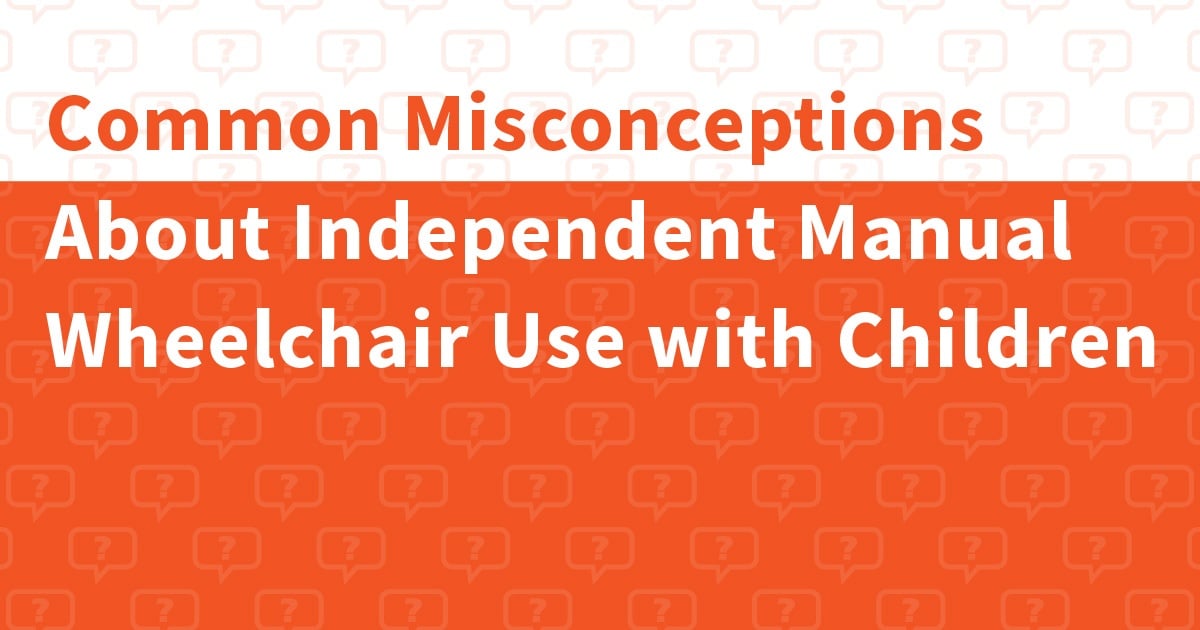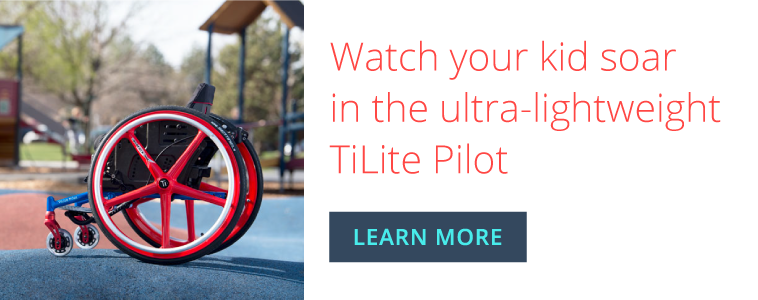Today we’re continuing our theme of early mobility options for children. Last week we introduced the manual wheelchair options, dependent (strollers) and independent, and clearly established the importance of independent movement for a child’s motor, sensory, and social development. But even when we understand the importance of independent mobility, there are common concerns and misconceptions that parents and sometimes teachers and therapists have that get in the way of making the best decision for the child. Today we’ll address some of these concerns and highlight some important features of independent manual mobility.
Common Misconceptions and Questions
"A manual wheelchair will slow my child from learning to walk."
Remember how I’ve talked about effective and efficient mobility? What is most important for your child is to be able to move and explore her environment independently. This is what will promote healthy development of motor and sensory systems as well as socialization. It doesn’t mean that your child can’t continue to work with a therapist on walking, but it provides independence and development in the meantime. So consider your child’s day-to-day function and what effective mobility would look like for each of these tasks. A good example may be that your child can be effective and tolerate walking in the home, then when at school he uses an independent manual wheelchair to navigate the halls and keep up with his peers.
"My child will never reach the milestone of walking if he/she is in a wheelchair."
Therapists are trained to evaluate childhood milestones and will develop treatment plans to help a child achieve those milestones. But as we’ve already discussed, early movement and mobility is critical in helping children achieve those milestones. So, providing them with alternate ways to be independent will promote the brain development required to make progress in all other areas.
Another important aspect to consider is the psycho-social component. Think of any child you know and consider how frustrated she gets when a task is hard and she can’t figure it out. Now think of a child who either can’t ambulate or can but with great difficulty. He wants a toy from his bedroom, but he can’t get it on his own. Or he can make it to his bedroom, but then he’s too worn out to play with the toy! Providing a child with the success of effective independent mobility is life changing and builds confidence and self-esteem.
"A manual wheelchair is too heavy."

It’s true that in the past manual wheelchairs were scaled-down versions of adult wheelchairs, which resulted in heavy, inefficient products for children. This is no longer the case! There are now ultralight options that can be configured to your child to be as efficient as possible. With an ultralight frame, your child can keep up with her friends and activities with less fatigue. Even younger children can maneuver an ultralight chair easily without feeling like they are pushing something heavier than they are. And parents won’t break their backs putting it in the car for outings!
"A manual wheelchair won't fit in our home."
As I already mentioned above, the old-style wheelchairs–essentially shrunken adult wheelchairs–were heavy and had a large footprint that affected maneuverability in the home. The new ultralight options can be fit like a prosthetic to your child, resulting in a small footprint that will fit most environments.

"I want people to see my child first, not the wheelchair."
With evolving wheelchair technology and increasing understanding of childhood development with disabilities, children’s manual wheelchairs have improved significantly. The options are now customizable and fun and can feel like a natural extension of your child’s body rather than an obtrusive device.
"My child will outgrow the manual chair. Then what?"
Traditionally, pediatric manual wheelchairs grow backwards. The wheel position is often compromised and slightly farther back, which is intended to allow for predicted chair growth. This can cause eventual strain on the shoulder and certainly promotes an inefficient push pattern that leads to fatigue and even pain. When it’s time to grow the chair, there is a significant reconfiguration of the wheelchair, and the wheel position will be changed, resulting in potential down time as the child learns the feel and maneuverability of the wheelchair. This can sometimes disrupt routines and daily activities.
With this concern in mind, Permobil has designed a child’s wheelchair that grows forward, mimicking your child’s body’s growth. With this wheelchair, the position of your child in relation to the wheels stays the same, ensuring the same efficient and safe push pattern without compromise. Once the growth adjustments have been made, your child can get right back to day-to-day activities without feeling like he’s in a new chair.

Although we’ve addressed several common concerns, we know that our list is not exhaustive. Please reach out to us if you have other questions and concerns. We want to support you with information and knowledge!
Next week we will look in more detail at how a manual wheelchair can grow, and the considerations for your child’s day to day function with each method of growth.
Glossary of Terms
Self-Awareness: An awareness of one's own personality or individuality
Spatial Orientation: An awareness of one’s position in space
Emotional Attachment: Feeling connected to others
Visual/Vestibular Integration: The connection between vision and balance for navigating one’s environment
Initiation: The act of initiating or beginning something
Trunk Stability: The ability to maintain a position of the upper body
Range of Motion: The range that a joint is able to move
Dependent Manual Wheelchair: A wheelchair that can not be moved without assistance
Independent Manual Wheelchair: A wheelchair that can be moved independently
Visual Motor Skills: The ability to synchronize visual information with physical movement, driving a car or playing a video game of skill
Depth Perception: The visual ability to judge depth or distance
Position in Space: Knowing where your body is in space relative to surrounding objects
Socialization: The ability to interact with others
Mobility: The ability to move
Ultralight Manual Wheelchair: Made of ultra lightweight materials such as aluminum, titanium, or carbon. Usually can be configured to fit the individual user
Dictionary. (2018). Retrieved from https://www.merriam-webster.com/dictionary/self-awareness?src=search-dict-box
References:
1. Rosen, L., Plummer, T., Sabet, A., Lange, M., & Livingstone, R. (2017). RESNA Position on the Application of Power Mobility Devices for Pediatric Users-Update 2017. Retrieved from https://www.resna.org/sites/default/files/legacy/Position-Papers/RESNA%20Ped%20Power%20Paper%2010_25_17%20-BOD%20approval%20Nov2_2017.pdf
2. Livingstone, R. (2011). Evidence for Practice- Power Mobility for School-Aged Children and Adolescents[Ebook]. Vancouver, British Columbia: Sunny Hill Health Centre for Children.
3. Milestones Checklist. (2018). Retrieved from https://pathways.org/wp-content/uploads/2015/06/MilestonesChecklist_UPDATED.pdf
Stroller and Wheelchair Icons created by https://www.flaticon.com/authors/freepik

Stacey Mullis, OTR/ATP
Director of Clinical Marketing
Stacey is Director of Clinical Marketing. She graduated from Western University in London, Ontario, Canada with a BA Linguistics and BSc Occupational Therapy and has practiced as an OTR for over 20 years. With experience in pediatrics, inpatient/outpatient rehabilitation, long term care, and home health, Stacey has faced the challenges first hand of providing appropriate seating in various clinical settings. This led her to pursue an apprenticeship at Care Partners Seating Clinic in Asheville, NC to advance her skills, and she obtained her ATP certification in 2012. Mullis is a member of the NCOTA, CTF, NRRTs, RESNA, and AOTA.

